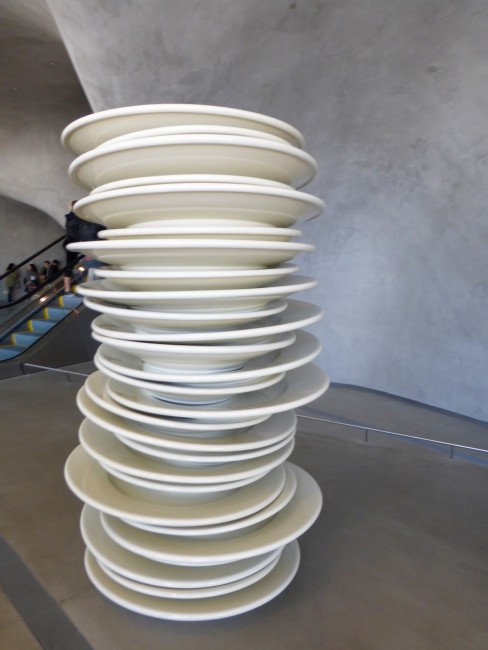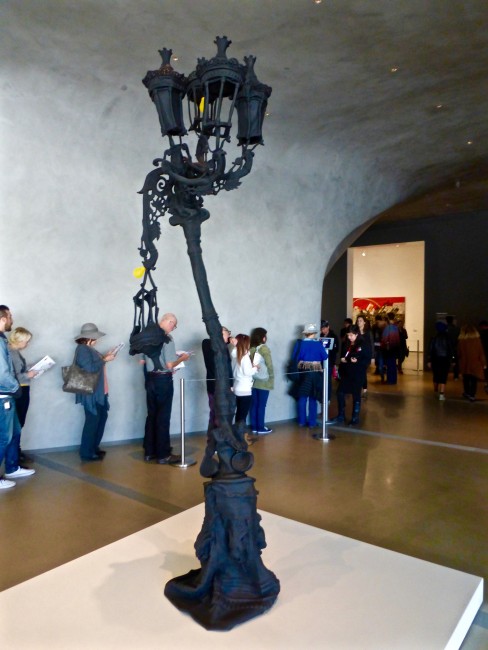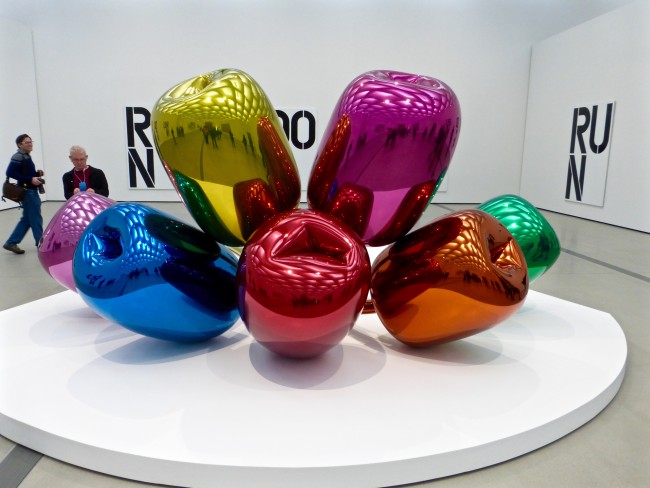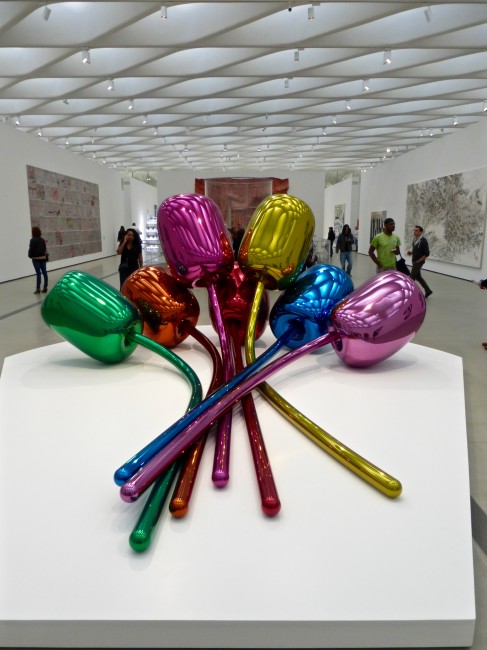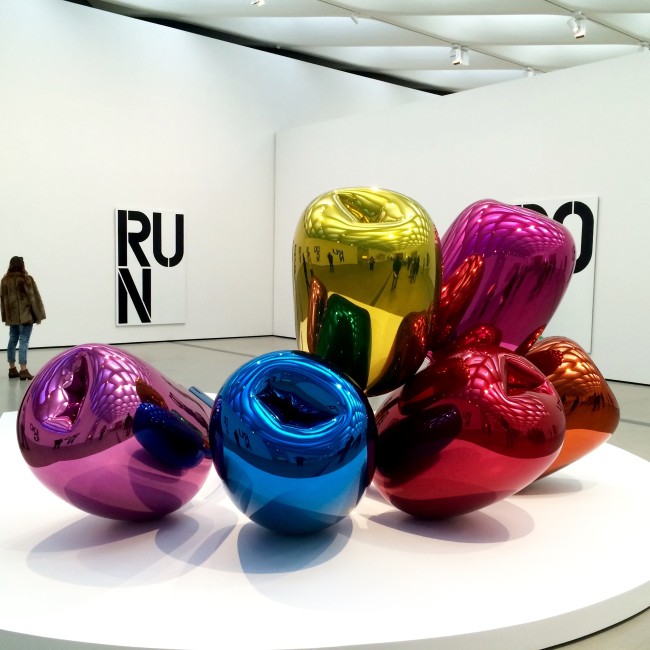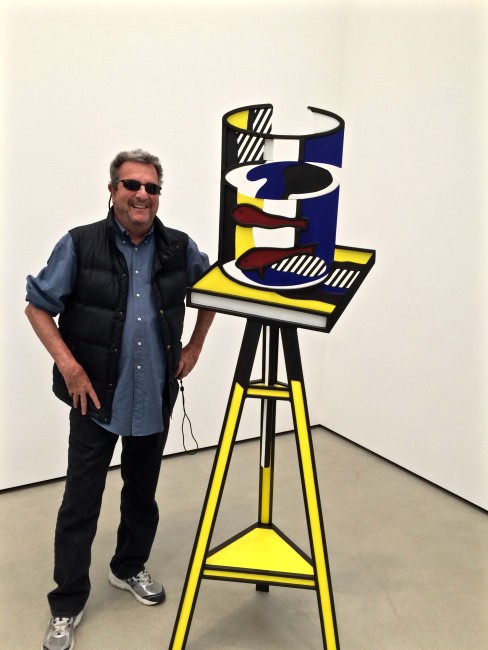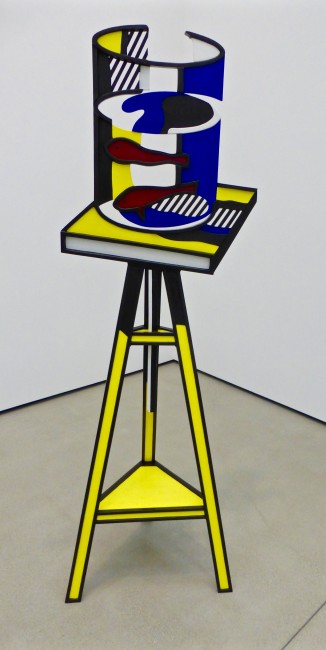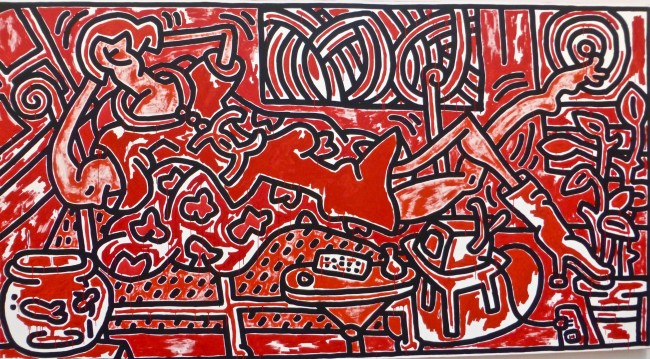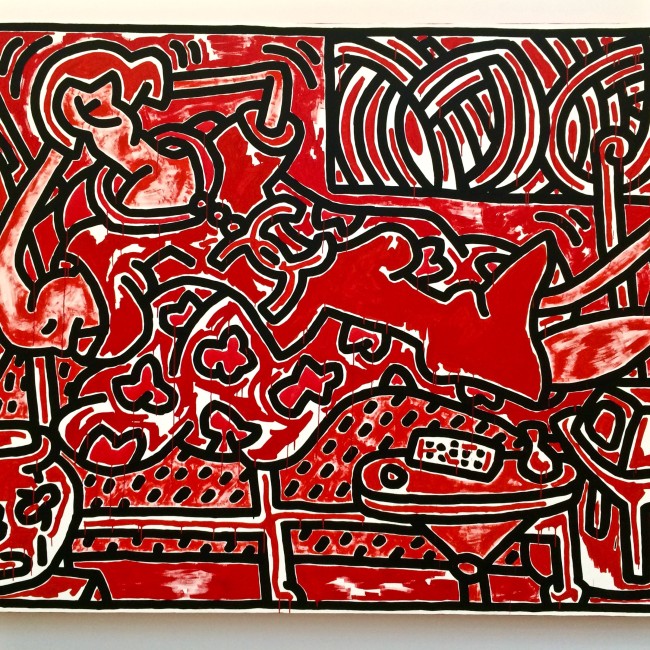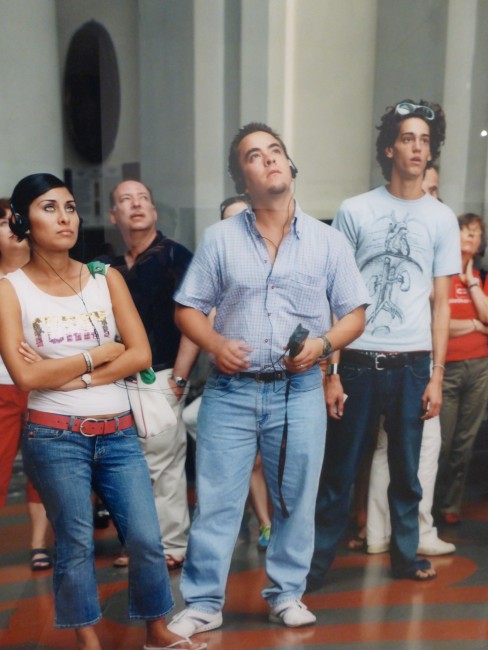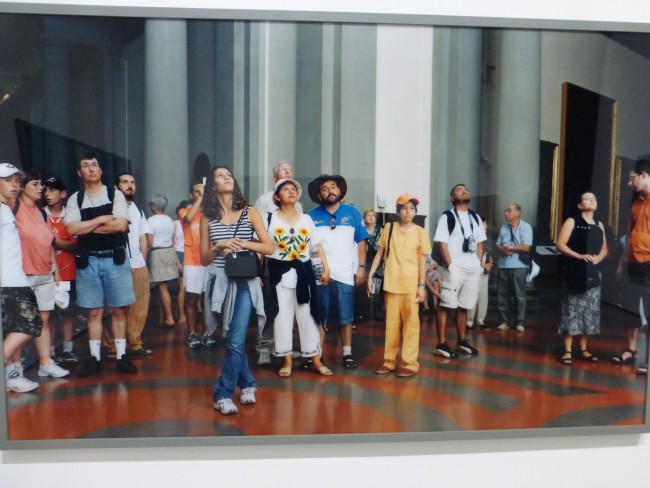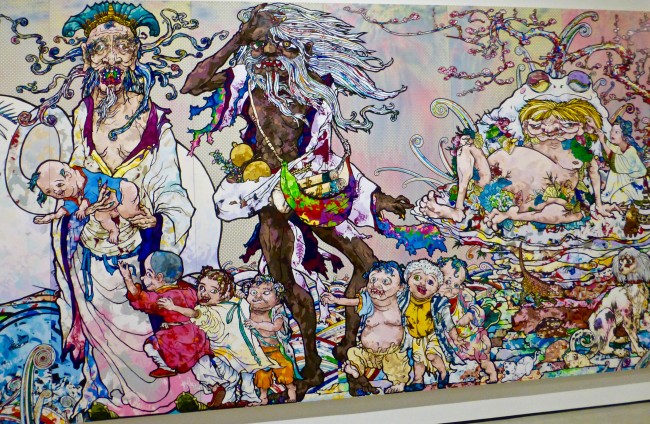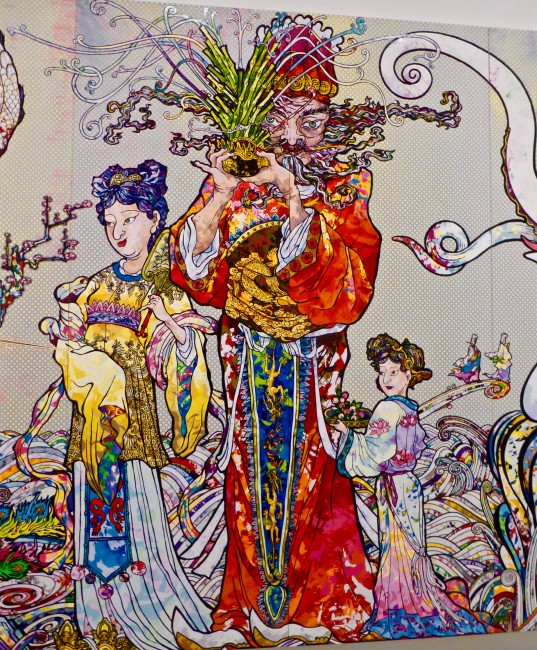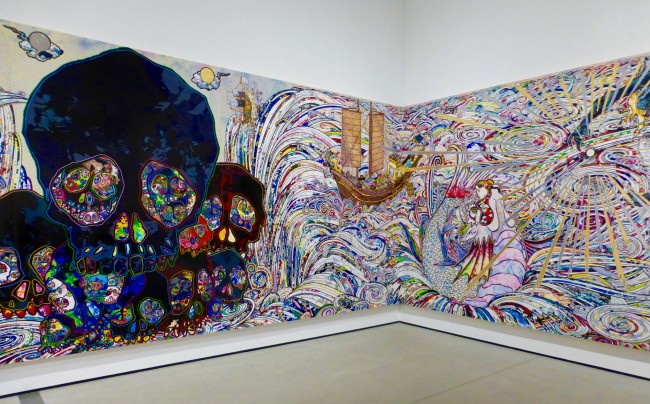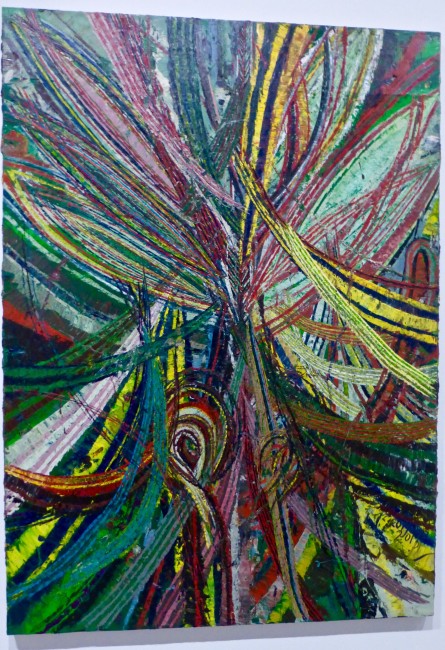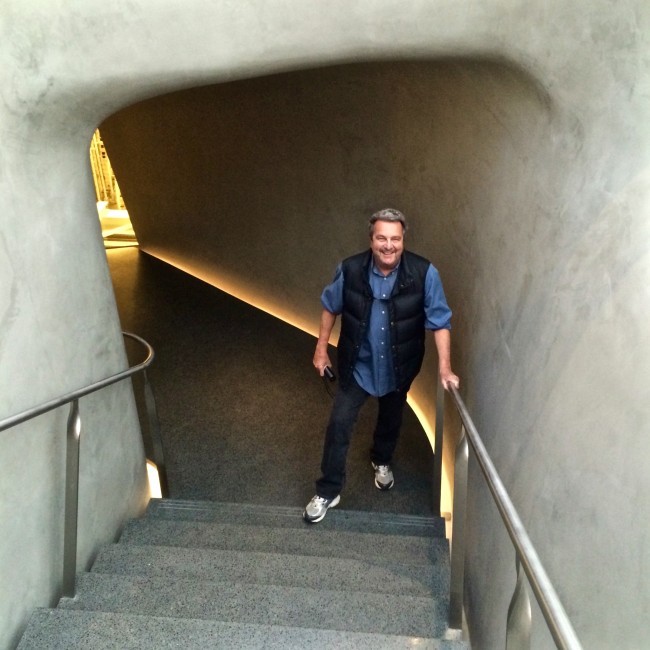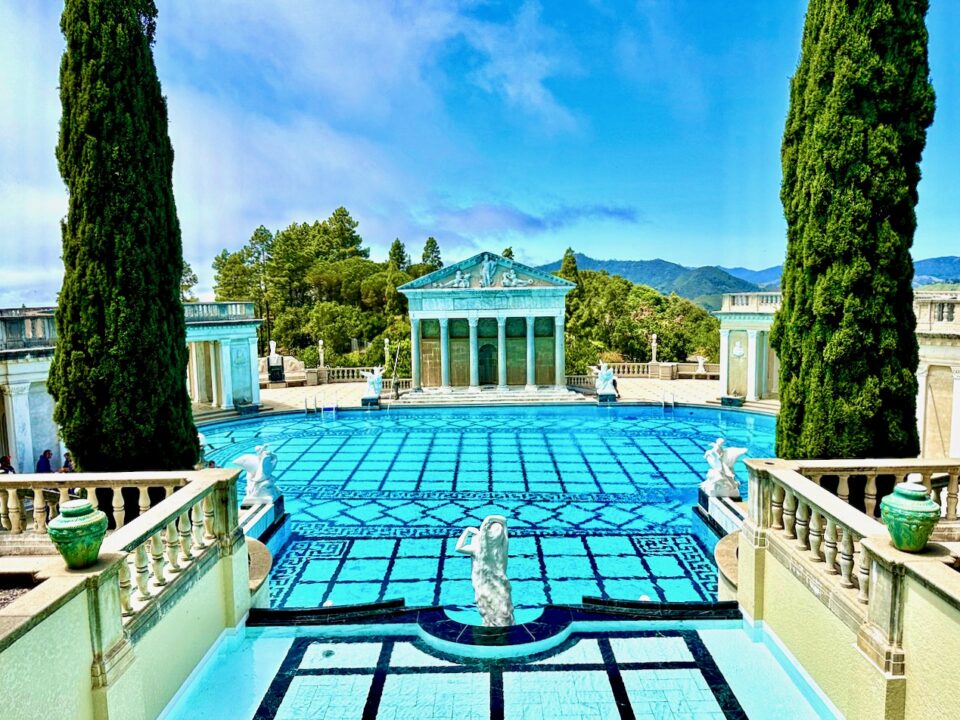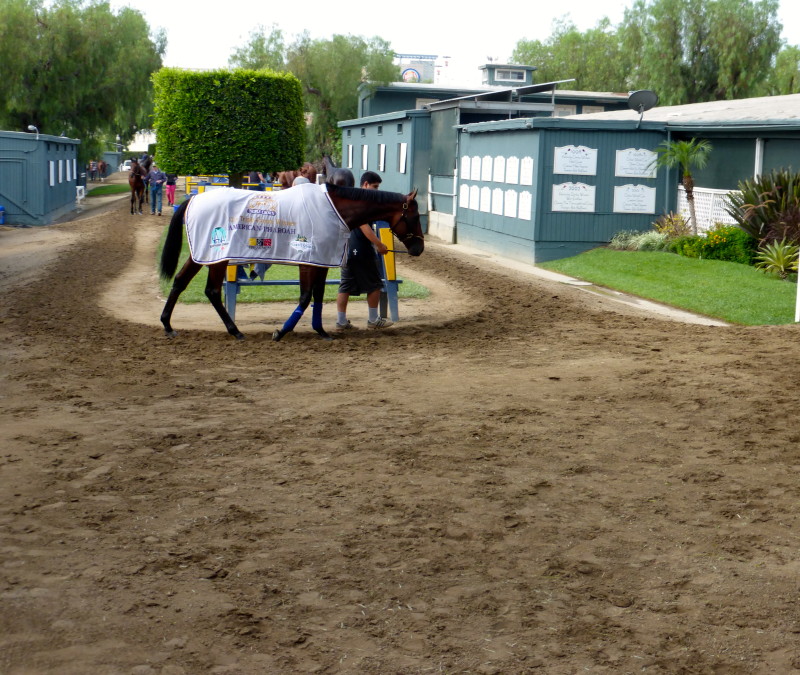
Santa Anita Park “Seabiscuit Tour” – Arcadia
June 29, 2015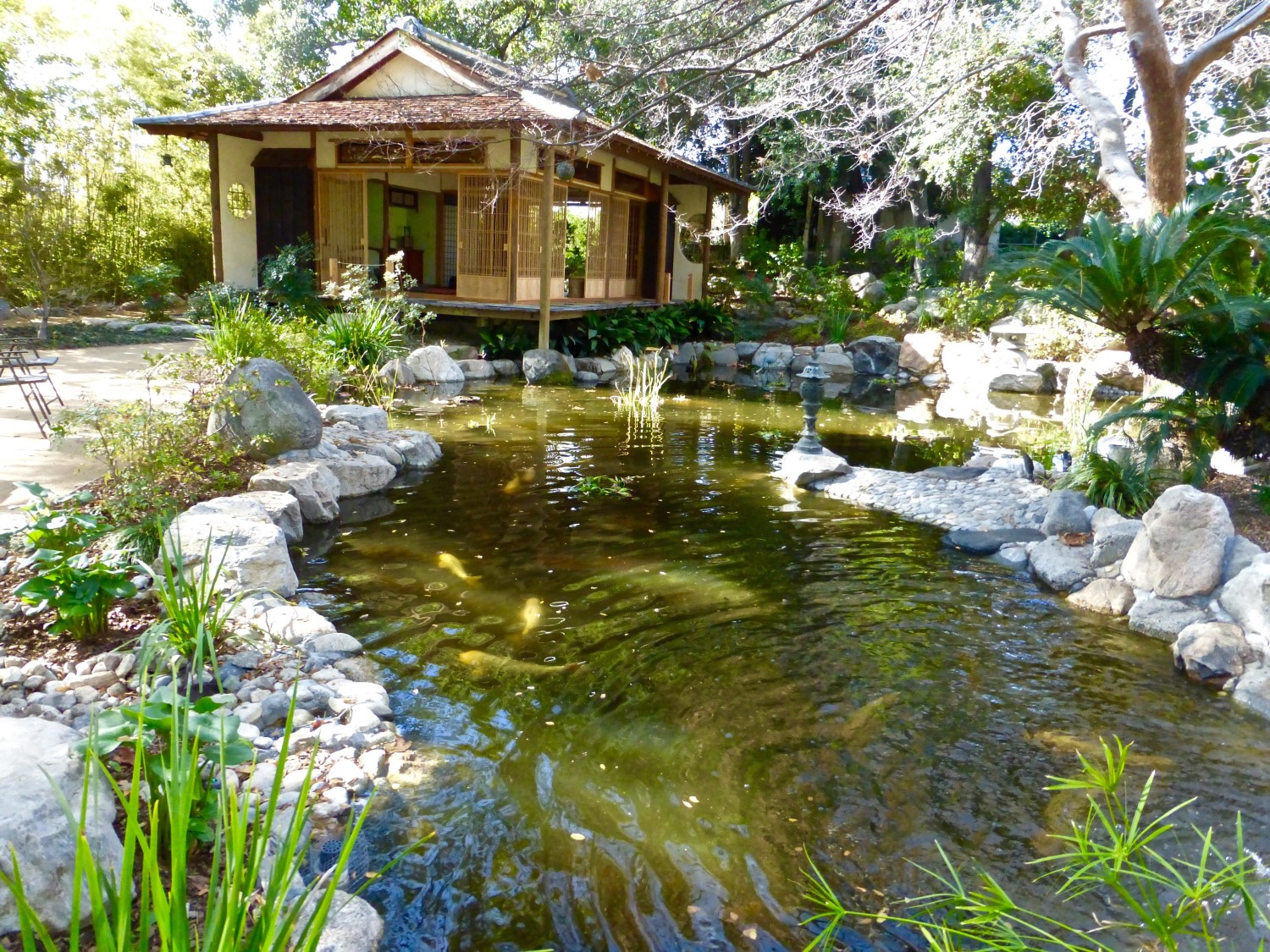
Storrier Stearns Japanese Garden – Pasadena
January 23, 2016Thoroughly Modern MaiTai
Visited: December 1, 2015
My life has been turned upside down.
If you read my Spain report (or any of my trip reports for that matter), you know Tracy and I are not aficionados of contemporary art. From the Fundació Joan Miró in Barcelona to the Museo Reina Sofía in Madrid to the Centre Georges Pompidou in Paris, we have never been to a contemporary art museum that we have enjoyed.
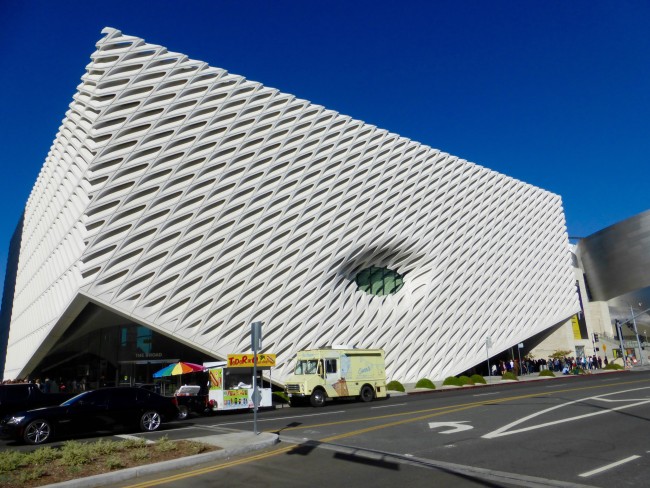 However, that doesn’t mean we aren’t willing to give these places a chance, and when we received the opportunity to visit The Broad (pronounced Brode), the new downtown Los Angeles contemporary art museum that just opened in September (and also the “hottest ticket in town”), we were grateful to take advantage of it. Lo and behold…we loved it! What’s this world coming to?
However, that doesn’t mean we aren’t willing to give these places a chance, and when we received the opportunity to visit The Broad (pronounced Brode), the new downtown Los Angeles contemporary art museum that just opened in September (and also the “hottest ticket in town”), we were grateful to take advantage of it. Lo and behold…we loved it! What’s this world coming to?
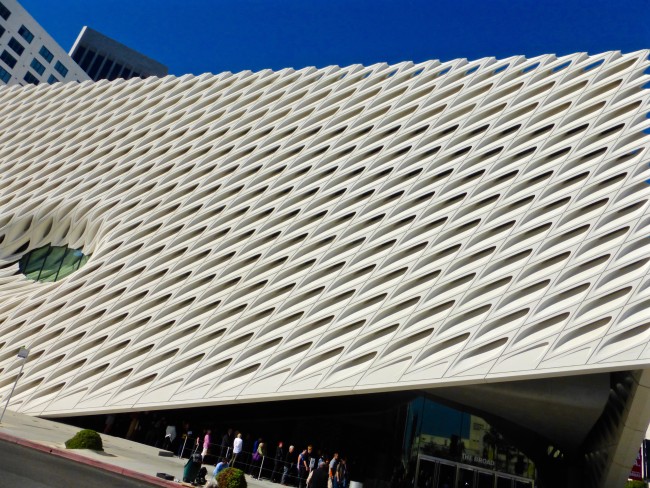 The Broad (named for developer Eli and Edythe Broad…Broad financed the $140 million dollar structure) was designed by Diller Scofido + Renfro, a world-renowned architectural firm. The Broads have been collecting post-war and contemporary pieces for the last half century. The building encompasses 120,000 square feet and features two floors of gallery space. There are more than 2,000 works by more than 200 artists.
The Broad (named for developer Eli and Edythe Broad…Broad financed the $140 million dollar structure) was designed by Diller Scofido + Renfro, a world-renowned architectural firm. The Broads have been collecting post-war and contemporary pieces for the last half century. The building encompasses 120,000 square feet and features two floors of gallery space. There are more than 2,000 works by more than 200 artists.
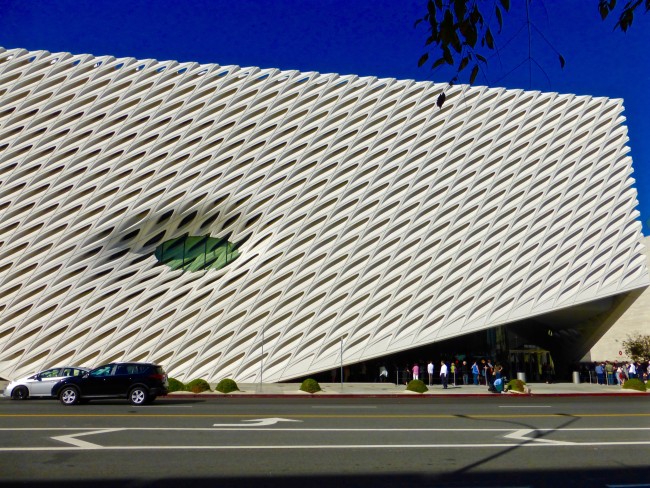 The façade (dubbed “the veil”) is “a honeycomb-like structure that spans across the block-long gallery and provides filtered natural sunlight,” which was apropos since the exterior was buzzing with people. The building is located adjacent from the Walt Disney Concert Hall, so it’s pretty cool being able to look at these two diverse architectural structures virtually side-by-side.
The façade (dubbed “the veil”) is “a honeycomb-like structure that spans across the block-long gallery and provides filtered natural sunlight,” which was apropos since the exterior was buzzing with people. The building is located adjacent from the Walt Disney Concert Hall, so it’s pretty cool being able to look at these two diverse architectural structures virtually side-by-side.
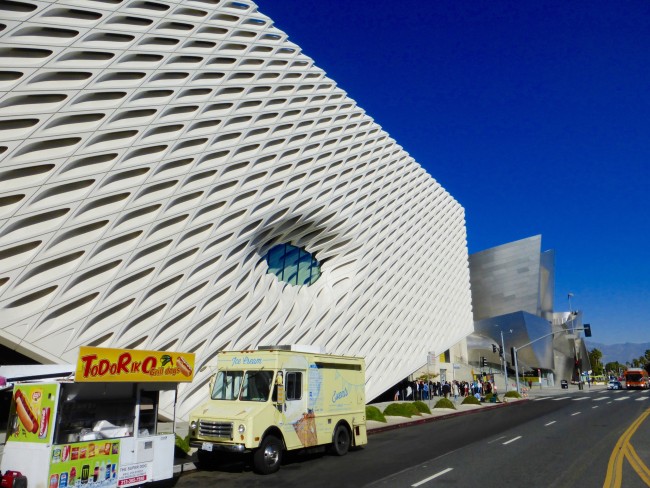 The museum is free of charge, but timed tickets for the remainder of 2015 have been sold out for quite some time (there is another line for walk-ups, but it can be quite long). Luckily, thanks to the generosity of TravelsWithMaiTaiTom subscriber Sascha (who was unable to attend her noon entrance time), Tracy and I were the benefactors of her two tickets. Our line got called a little early, and in we went.
The museum is free of charge, but timed tickets for the remainder of 2015 have been sold out for quite some time (there is another line for walk-ups, but it can be quite long). Luckily, thanks to the generosity of TravelsWithMaiTaiTom subscriber Sascha (who was unable to attend her noon entrance time), Tracy and I were the benefactors of her two tickets. Our line got called a little early, and in we went.
Upon entering the cave-like foyer (“the vault”), the first couple of pieces of artwork I saw in the lobby were a stack of plates and a cool lamppost. I also downloaded The Broad App,which gives you info on the architecture, artists, artwork and more. Then I witnessed a long line.
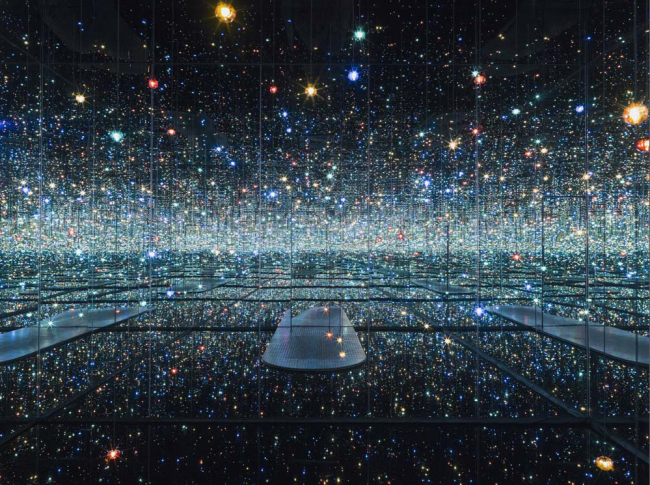 I inquired with one of the many staff members who told me the long line was for entry to Yayoi Kusama’s “Infinity Mirrored Room,” (photo above from The Broad website) which is a “a mirror-lined chamber housing a dazzling and seemingly endless LED light display.” The experiential artwork on the museum’s first floor has limited capacity. It accommodates one visitor at a time for approximately 45 seconds and requires a separate, free timed ticket, which general admission ticket holders will be able to reserve after arrival at the museum. Today’s wait was three hours, which was longer than we had time to stay, but we will try and get back here before this exhibition leaves.
I inquired with one of the many staff members who told me the long line was for entry to Yayoi Kusama’s “Infinity Mirrored Room,” (photo above from The Broad website) which is a “a mirror-lined chamber housing a dazzling and seemingly endless LED light display.” The experiential artwork on the museum’s first floor has limited capacity. It accommodates one visitor at a time for approximately 45 seconds and requires a separate, free timed ticket, which general admission ticket holders will be able to reserve after arrival at the museum. Today’s wait was three hours, which was longer than we had time to stay, but we will try and get back here before this exhibition leaves.
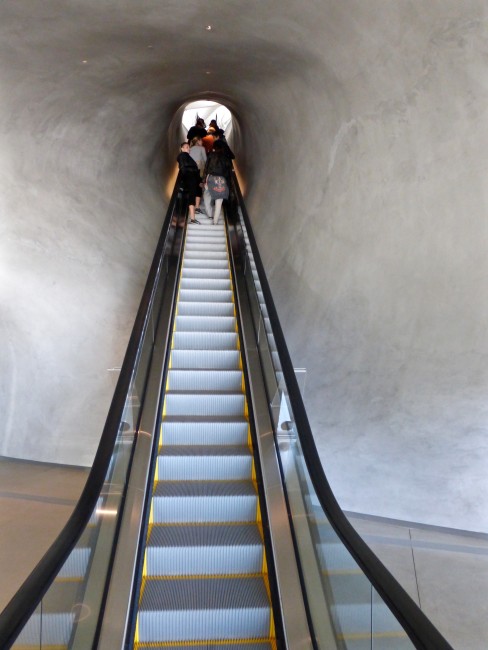 It was time to head up the 105-foot escalator that transports you through the cave to the third floor.
It was time to head up the 105-foot escalator that transports you through the cave to the third floor.
Giant, colorful tulips courtesy of artist Jeff Koons greeted us. Tiny Tim would have loved to tiptoe through these mirror-polished stainless steel beauties with a transparent color coating.
Koons also created a colorful party hat. I think this was my favorite painting at The Broad. We’d see more of Koons’ work a little bit later.
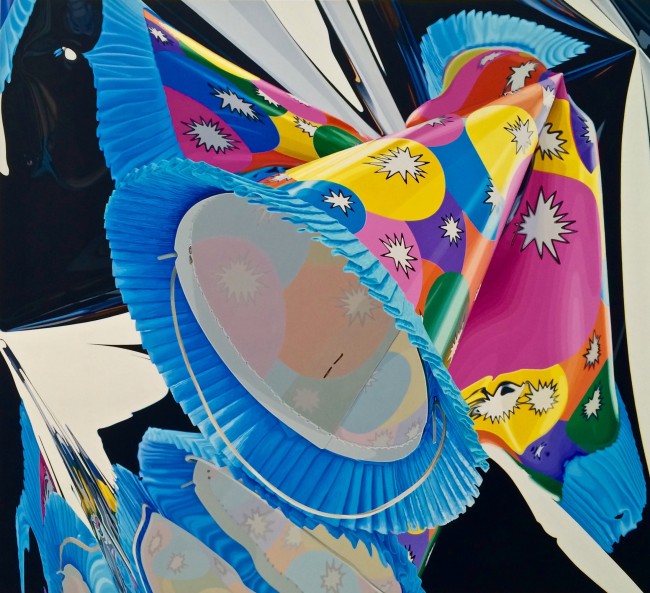 In an adjacent room, the world of Andy Warhol was on display. The first work we viewed was his “Twenty Jackies.” It depicts Jackie Kennedy at her husband’s funeral.
In an adjacent room, the world of Andy Warhol was on display. The first work we viewed was his “Twenty Jackies.” It depicts Jackie Kennedy at her husband’s funeral.
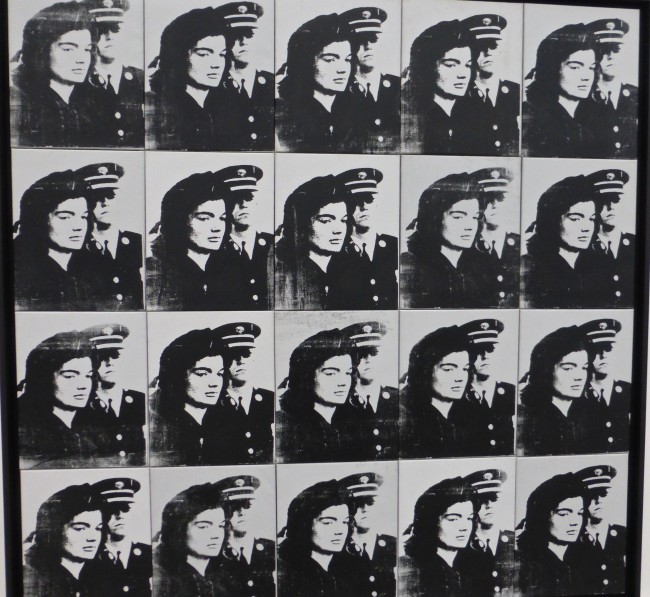 Across the room there were a couple of Campbell’s soup cans and things mushroomed from there.
Across the room there were a couple of Campbell’s soup cans and things mushroomed from there.
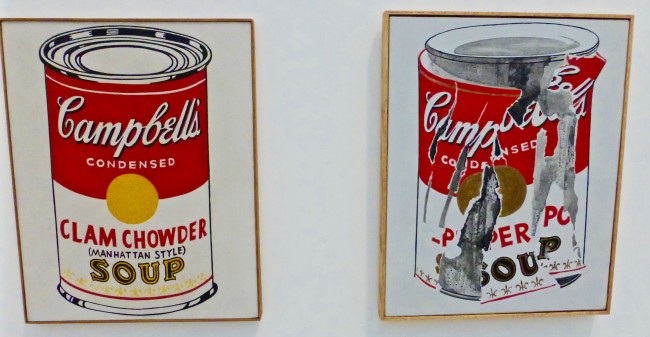 “Single Elvis” (must have been after the divorce), a silkscreen painting depicting the singer dressed as a cowboy, shooting from the hip against a silver background, was our next stop. Thank you very much!
“Single Elvis” (must have been after the divorce), a silkscreen painting depicting the singer dressed as a cowboy, shooting from the hip against a silver background, was our next stop. Thank you very much!
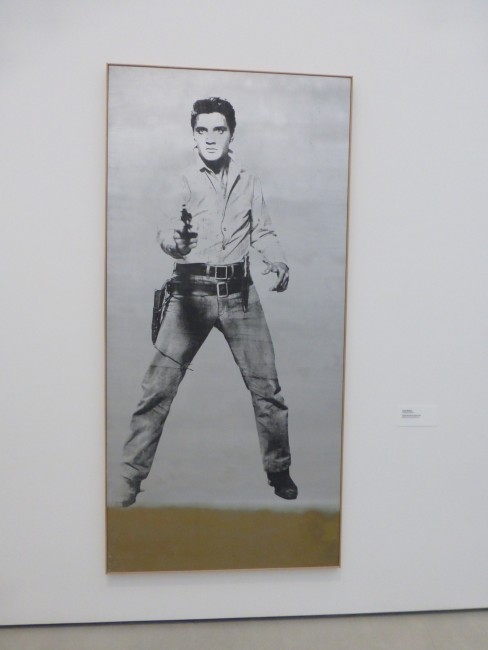 And what’s better than one Marilyn Monroe? Why two, of course.
And what’s better than one Marilyn Monroe? Why two, of course.
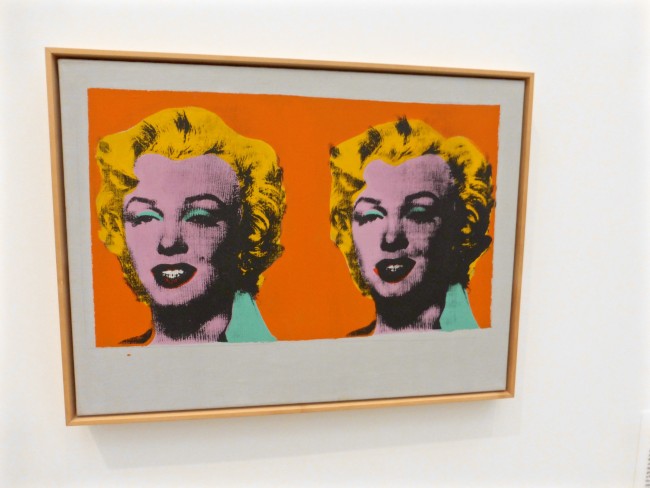 Back in the old days, after a night of carousing with my buddy Jeff, we’d end up at Norm’s restaurant on La Cienega Blvd. in Beverly Hills. Much to my surprise, artist Edward Ruscha has put it on canvas. I don’t think I have ever seen Norm’s exterior sober, however Ruscha’s painting kind of looks how I remember it while drunk.
Back in the old days, after a night of carousing with my buddy Jeff, we’d end up at Norm’s restaurant on La Cienega Blvd. in Beverly Hills. Much to my surprise, artist Edward Ruscha has put it on canvas. I don’t think I have ever seen Norm’s exterior sober, however Ruscha’s painting kind of looks how I remember it while drunk.
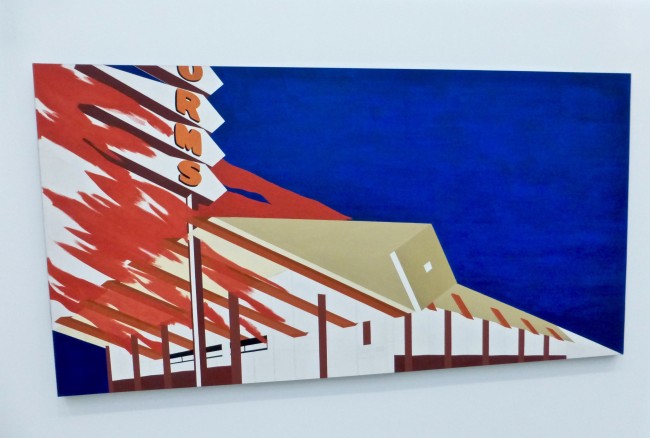 Ruscha was ahead of his time in 1965 with his Angry Bird. The bird is angry because that’s plaster…not milk (and I guess he didn’t want to get plastered). Hey, this modern art is kinda fun, after all.
Ruscha was ahead of his time in 1965 with his Angry Bird. The bird is angry because that’s plaster…not milk (and I guess he didn’t want to get plastered). Hey, this modern art is kinda fun, after all.
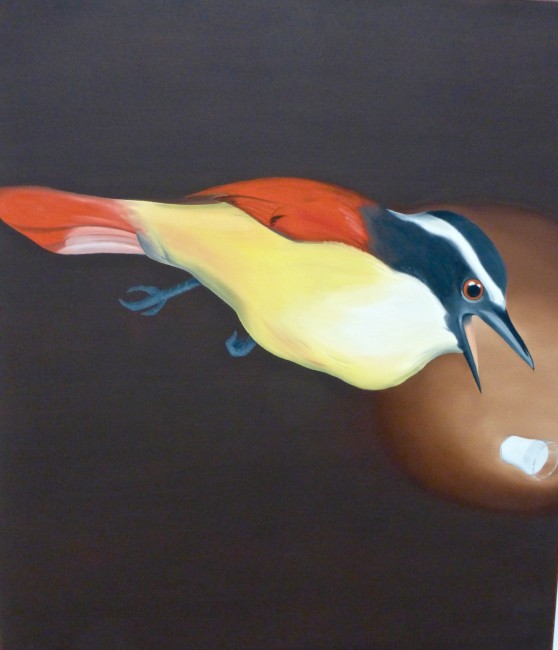 Cy Twombly, who moved from New York to Italy in the late 1950s had a couple of interesting paintings…“Leaving Paphos Ringed With Waves” (have no idea what that means)…
Cy Twombly, who moved from New York to Italy in the late 1950s had a couple of interesting paintings…“Leaving Paphos Ringed With Waves” (have no idea what that means)…
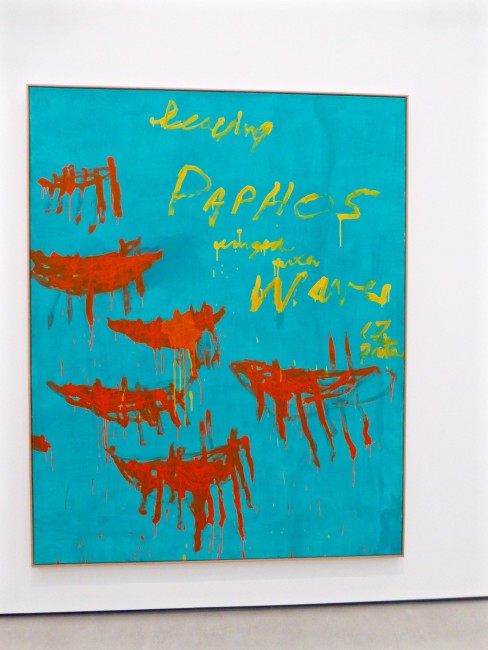 …and The Rose, although I’m glad the ones in our garden don’t look like those.
…and The Rose, although I’m glad the ones in our garden don’t look like those.
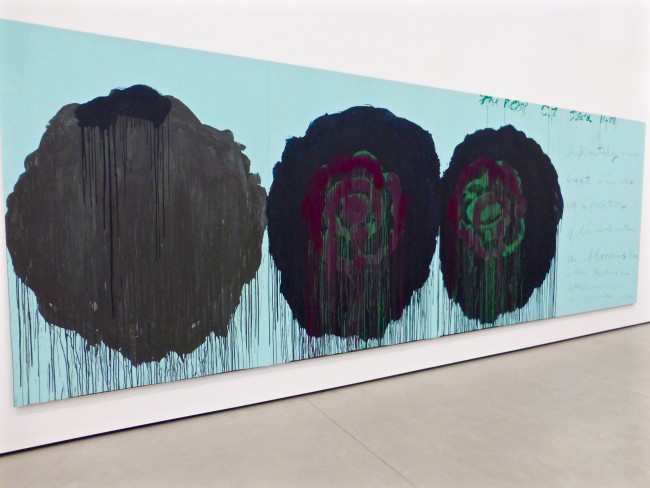 German Anselm Kiefer’s “Deutschlands Geistesheldon” caught my eye, and thankfully I didn’t attempt to pronounce it.
German Anselm Kiefer’s “Deutschlands Geistesheldon” caught my eye, and thankfully I didn’t attempt to pronounce it.
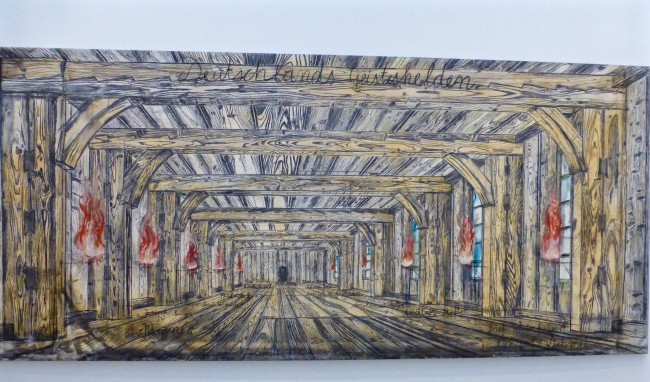 Tracy and I then visited Lichtenstein…Roy Lichtenstein. This is what Pop Art looks like. “I…I’m Sorry” portrays Eve as a modern day woman (I could hear Brenda Lee singingas we looked at it). The Broad app read, “Lichtenstein renders her apology unclear, revealing layers of interpretation: Is she apologizing for eating the forbidden fruit from the tree? Is she breaking our hearts? Is she sincere with her stammering words?” I’m sorry, I don’t know the answer.
Tracy and I then visited Lichtenstein…Roy Lichtenstein. This is what Pop Art looks like. “I…I’m Sorry” portrays Eve as a modern day woman (I could hear Brenda Lee singingas we looked at it). The Broad app read, “Lichtenstein renders her apology unclear, revealing layers of interpretation: Is she apologizing for eating the forbidden fruit from the tree? Is she breaking our hearts? Is she sincere with her stammering words?” I’m sorry, I don’t know the answer.
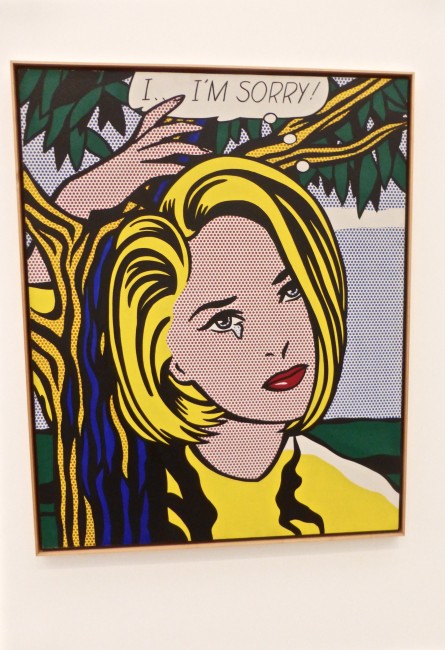 For a moment I was a fish out of water when I posed next to Lichtenstein’s “Goldfish Bowl.”
For a moment I was a fish out of water when I posed next to Lichtenstein’s “Goldfish Bowl.”
As a man of high caliber I couldn’t leave without checking out Lichtenstein’s “Live Ammo (Blang).” It was a blast.
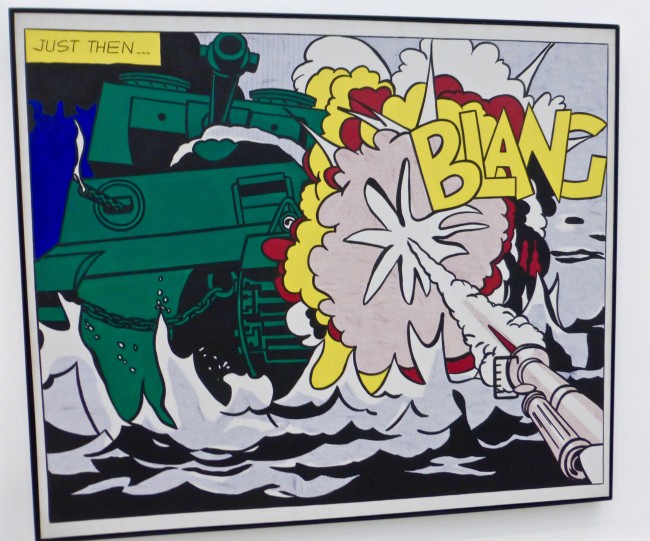 Soon we were back with some art from Jeff Koons. We really enjoyed his stuff.
Soon we were back with some art from Jeff Koons. We really enjoyed his stuff.
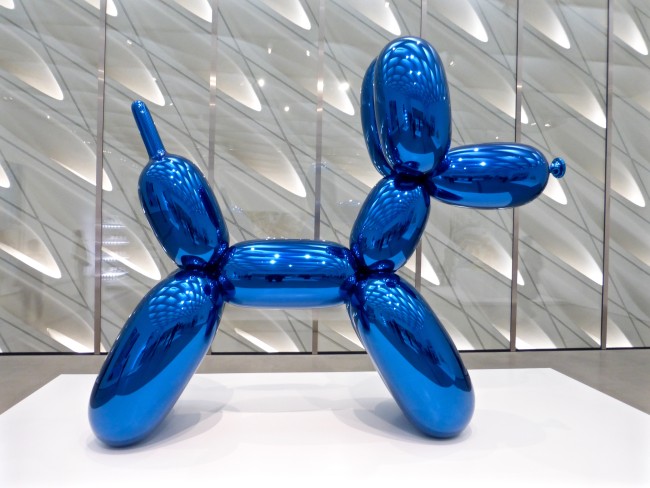 Walking into the room we were greeted by “Balloon Dog (Blue),” which according to The Broad website, “may be his most imposing work.” The dog is 12-feet high and constructed of mirror-polished stainless steel.
Walking into the room we were greeted by “Balloon Dog (Blue),” which according to The Broad website, “may be his most imposing work.” The dog is 12-feet high and constructed of mirror-polished stainless steel.
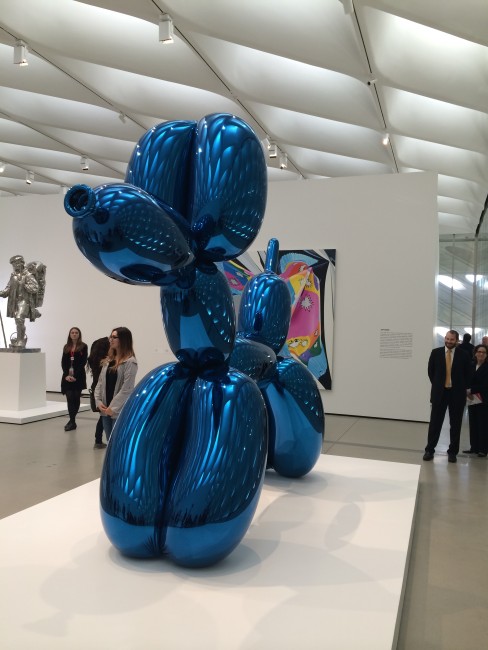 Koons didn’t monkey around when he created Michael Jackson and Bubbles. I hear critics “went ape” about this piece, which was a Thriller for many in attendance.
Koons didn’t monkey around when he created Michael Jackson and Bubbles. I hear critics “went ape” about this piece, which was a Thriller for many in attendance.
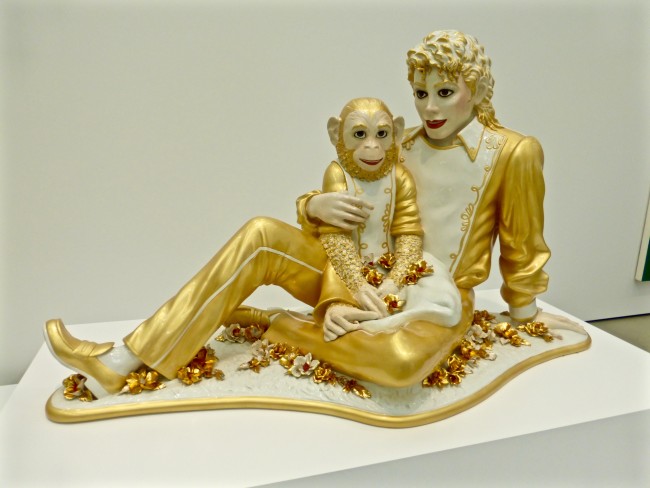 There was no splitting hares when it came to Koons’ “Inflatable Flower and Bunny (Tall White, Pink Bunny).”
There was no splitting hares when it came to Koons’ “Inflatable Flower and Bunny (Tall White, Pink Bunny).”
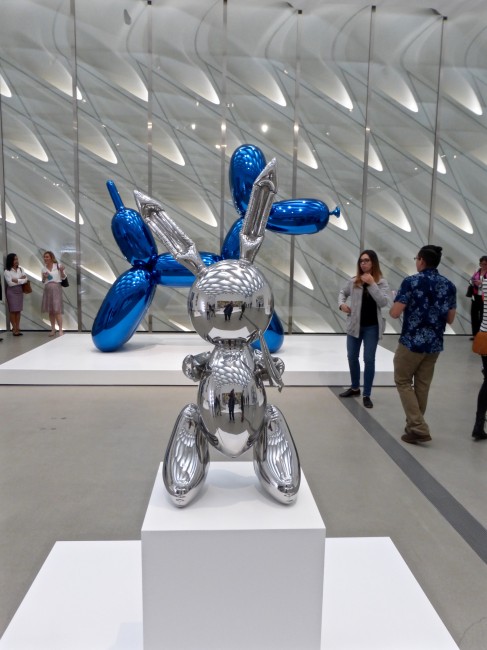 Enjoying the “Three Ball 50/50 Tank (Two Spalding Dr. J Silver Series, Wilson Supershot),” which features three floating basketballs, was a slam dunk.
Enjoying the “Three Ball 50/50 Tank (Two Spalding Dr. J Silver Series, Wilson Supershot),” which features three floating basketballs, was a slam dunk.
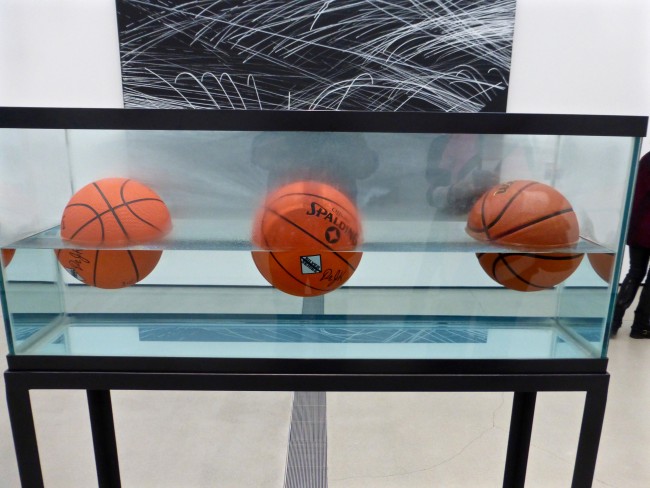 The last Koons’ work we took a photo of was a piece called “Kiepenkerl,” a stainless steel sculpture based on the traveling peddlers statue in Munster, Germany.
The last Koons’ work we took a photo of was a piece called “Kiepenkerl,” a stainless steel sculpture based on the traveling peddlers statue in Munster, Germany.
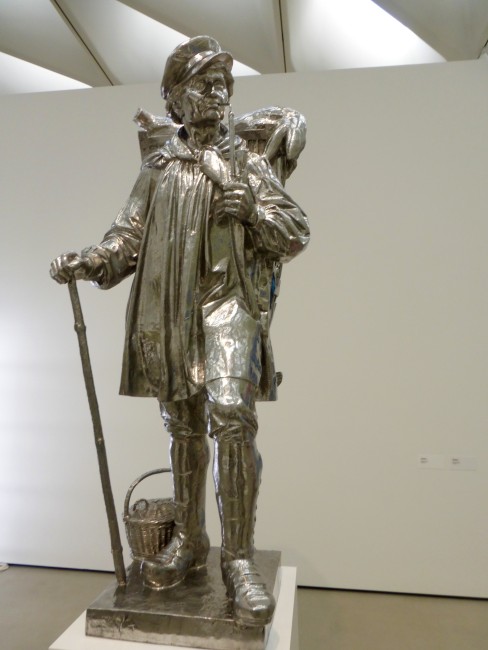 Lari Pittman’s “Like You” is a colorful mural that consists of five panels. According to The Broad, “the city portrayed may even be Los Angeles in the aftermath of the 1992 riots.” I believe that might be correct, since everyone seemed to be “getting along” at the museum.
Lari Pittman’s “Like You” is a colorful mural that consists of five panels. According to The Broad, “the city portrayed may even be Los Angeles in the aftermath of the 1992 riots.” I believe that might be correct, since everyone seemed to be “getting along” at the museum.
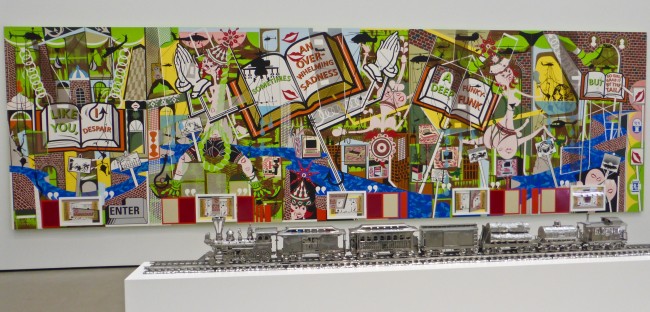 Since it was early in the day I had not been drinking, however soon I found myself “Under The Table,” which is actually a work by Chicago’s Robert Therrien (and perhaps my obituary title).
Since it was early in the day I had not been drinking, however soon I found myself “Under The Table,” which is actually a work by Chicago’s Robert Therrien (and perhaps my obituary title).
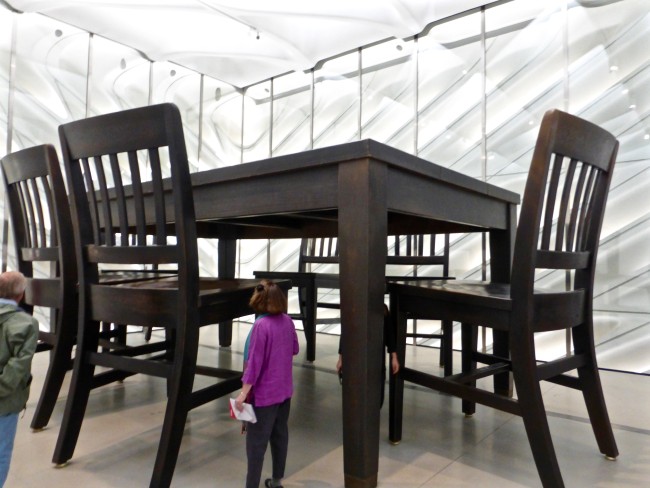 For just a minute, I thought I could be starring in “The Incredible Shrinking Man.”
For just a minute, I thought I could be starring in “The Incredible Shrinking Man.”
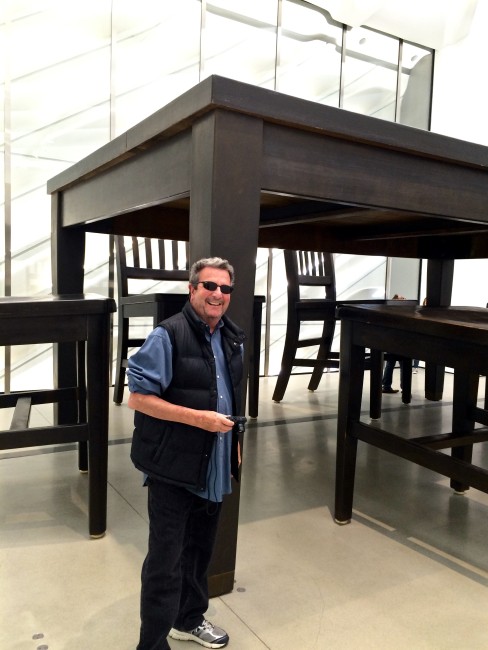 I feel a little sheepish talking about Damien Hirst’s “Away From The Flock.” It’s a little creepy. It’s described like this: “Away from the Flock features a lifeless sheep suspended in formaldehyde within a glass-walled tank. The sheep on display represents the limits of preservation, its inability to evade death. The work forces us to address our own ultimate mortality, resulting in emotional, empathetic responses.” We quickly took it on the lamb and hoped Hirst hadn’t pulled the wool over our eyes.
I feel a little sheepish talking about Damien Hirst’s “Away From The Flock.” It’s a little creepy. It’s described like this: “Away from the Flock features a lifeless sheep suspended in formaldehyde within a glass-walled tank. The sheep on display represents the limits of preservation, its inability to evade death. The work forces us to address our own ultimate mortality, resulting in emotional, empathetic responses.” We quickly took it on the lamb and hoped Hirst hadn’t pulled the wool over our eyes.
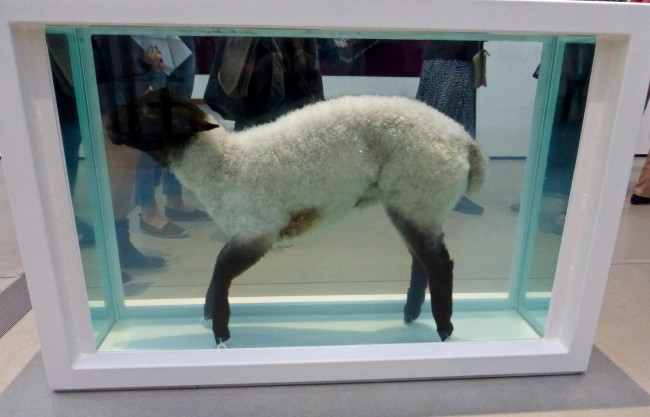 We stopped by a gold Urinal, but thankfully (and since it was in the middle of a large room) I had gone before I left.
We stopped by a gold Urinal, but thankfully (and since it was in the middle of a large room) I had gone before I left.
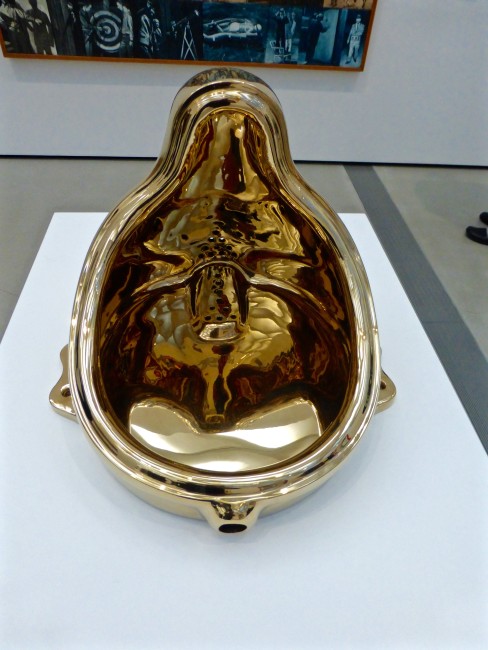 I might be going a little out of order now (we were still on the third floor, however), but shortly thereafter we saw Barbara Kruger’s 1989 “Untitled: Your Body Is A Battleground.” It was produced by Kruger for the Women’s March on Washington in support of reproductive freedom.
I might be going a little out of order now (we were still on the third floor, however), but shortly thereafter we saw Barbara Kruger’s 1989 “Untitled: Your Body Is A Battleground.” It was produced by Kruger for the Women’s March on Washington in support of reproductive freedom.
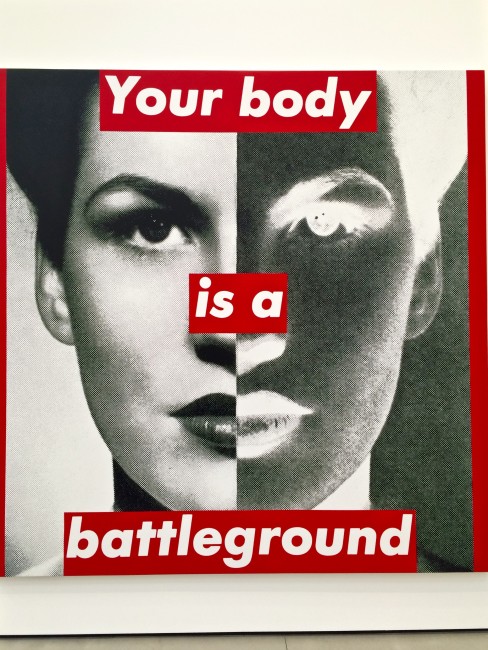 Jeff Wall’s sobering photograph “Dead Troops Talk (a vision after an ambush of a Red Army Patrol, near Moqor, Afghanistan, winter 1986),” is a fictional scene that “depicts a battlefield with soldiers coming back to life.” Wall is known for creating “elaborately staged transparencies that are displayed in light boxes.” It is an interesting effect.
Jeff Wall’s sobering photograph “Dead Troops Talk (a vision after an ambush of a Red Army Patrol, near Moqor, Afghanistan, winter 1986),” is a fictional scene that “depicts a battlefield with soldiers coming back to life.” Wall is known for creating “elaborately staged transparencies that are displayed in light boxes.” It is an interesting effect.
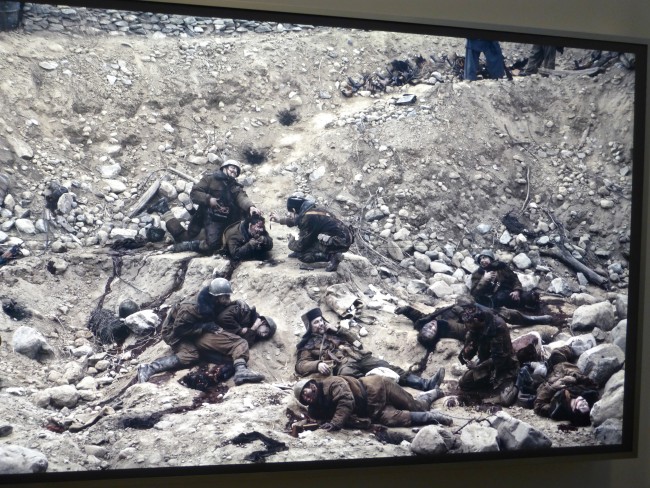 One room had some graffiti art on the walls with a guy and his dog plopping down in the middle.
One room had some graffiti art on the walls with a guy and his dog plopping down in the middle.
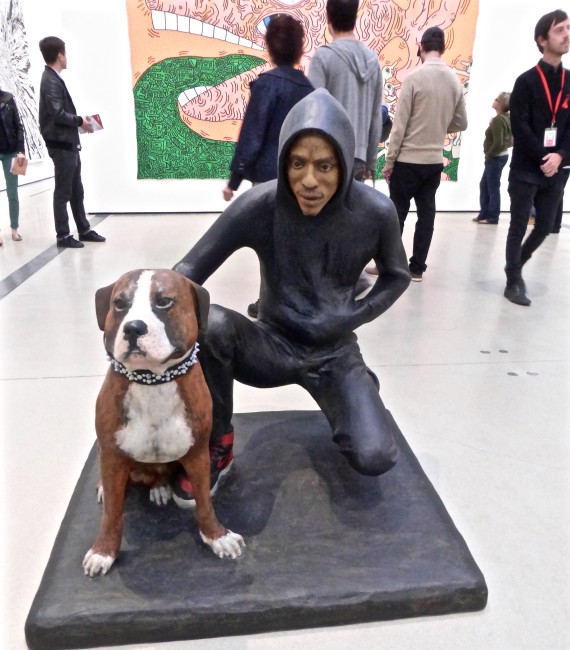 Jean Michel Basquiat and Keith Haring were friends from the downtown art scene in New York City. Their art has gone from chalk drawings in subway stations to hanging in art galleries. Unfortunately, neither are around to see it. Haring’s Red Room jumps off the wall…
Jean Michel Basquiat and Keith Haring were friends from the downtown art scene in New York City. Their art has gone from chalk drawings in subway stations to hanging in art galleries. Unfortunately, neither are around to see it. Haring’s Red Room jumps off the wall…
…and the painting below (which is untitled) the Broad website says, “presents a critique of the excesses of capitalism. The overtired pig is suckled by little men born out of the creature’s own vomit. The spew itself is money green and made of the machinery of production, acceleration, and increase. The cyclical image leaves no one in control and no way out.” Haring died in 1990 of AIDS-related complications at the age of 31.
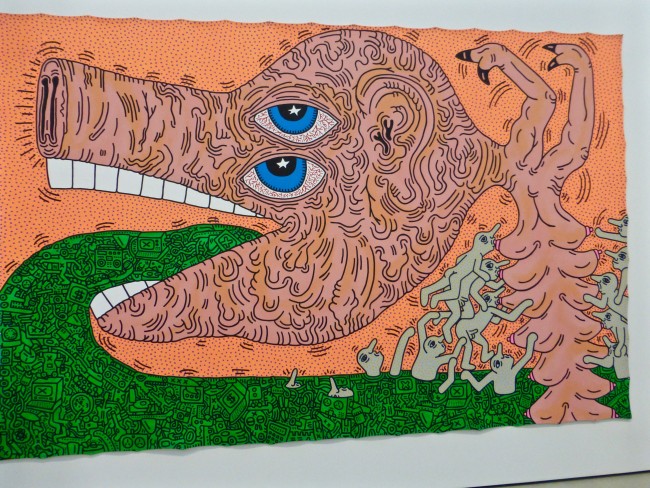 Basquait’s “Horn Players” is an homage to the great horn players Charlie Parker and Dizzy Gillespie. On the left is Parker with his alto saxophone and on the right is Gillespie with his trumpet. Basquiat was quite a jazz fan, and by the 1980s he was one of the most important American artists, but he had his demons.
Basquait’s “Horn Players” is an homage to the great horn players Charlie Parker and Dizzy Gillespie. On the left is Parker with his alto saxophone and on the right is Gillespie with his trumpet. Basquiat was quite a jazz fan, and by the 1980s he was one of the most important American artists, but he had his demons.
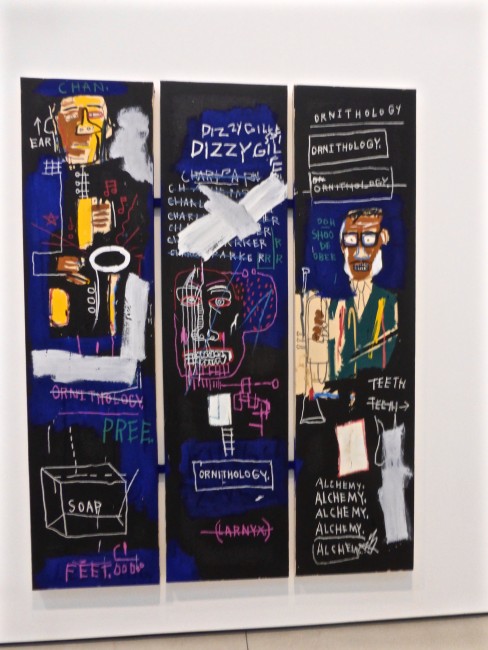 Basquait died in 1988 of a heroin overdose at his art studio in Manhattan’s NoHo neighborhood. Below is his painting “Obnoxious Liberals,” which I found out was not commissioned by Ted Cruz.
Basquait died in 1988 of a heroin overdose at his art studio in Manhattan’s NoHo neighborhood. Below is his painting “Obnoxious Liberals,” which I found out was not commissioned by Ted Cruz.
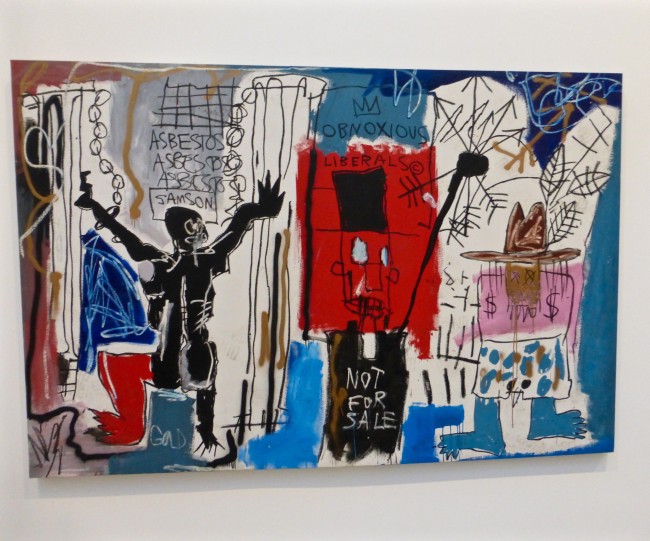 We walked down from the third floor to the first (the second floor contains paintings and art pieces that are rotated in and out…plus they have real places to go to the bathroom, unlike the gold urinal).
We walked down from the third floor to the first (the second floor contains paintings and art pieces that are rotated in and out…plus they have real places to go to the bathroom, unlike the gold urinal).
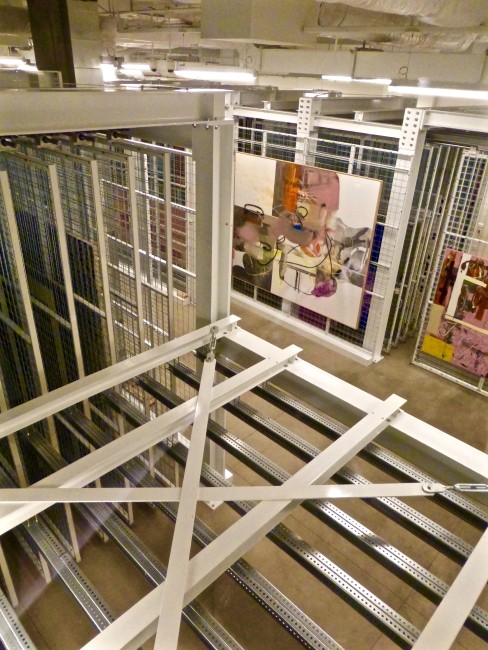 Downstairs, the first room I entered contained photos of people at an art gallery looking at something (sot of like me). Thomas Struth took a bunch of pictures of people gazing at Michelangelo’s David at the Galleria Dell’Accademia in Florence. Although the premise sounds weird, the photos were rather interesting.
Downstairs, the first room I entered contained photos of people at an art gallery looking at something (sot of like me). Thomas Struth took a bunch of pictures of people gazing at Michelangelo’s David at the Galleria Dell’Accademia in Florence. Although the premise sounds weird, the photos were rather interesting.
In another room, “End Of Line” by Takashi Murakami was another of those paintings about death I liked (I quickly put my psychologist on speed dial)…
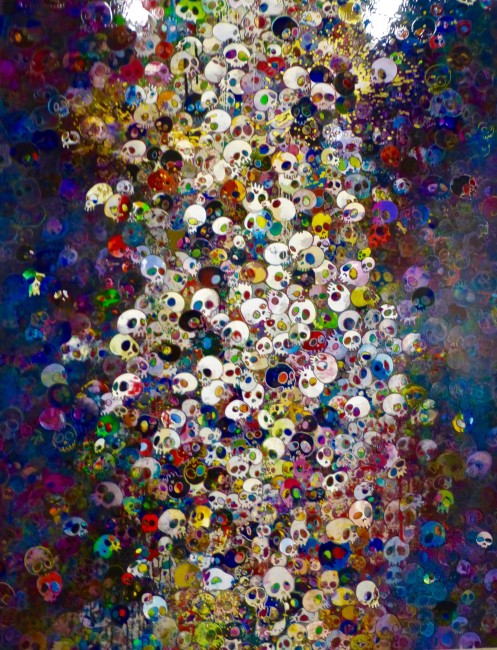 …and his “DOB in the Strange Forest (Blue DOB)” characters in the center of the room looked like something you’d see while on an LSD trip.
…and his “DOB in the Strange Forest (Blue DOB)” characters in the center of the room looked like something you’d see while on an LSD trip.
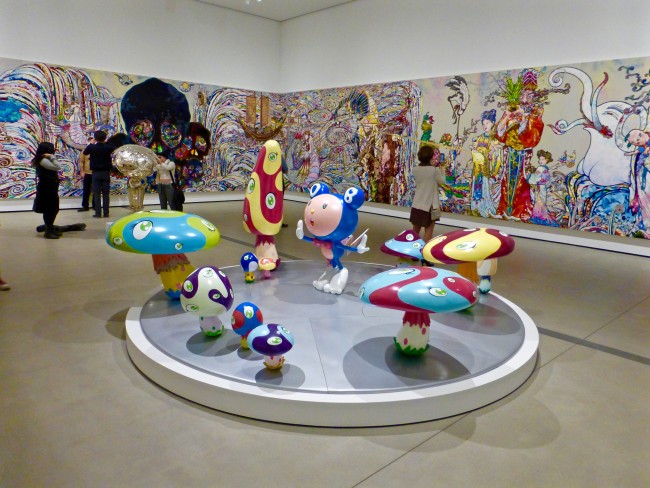 But the highlight of this room was the 82-foot long mural by Murakami, “In The Land Of The Dead, Stepping On The Tail Of A Rainbow.”
But the highlight of this room was the 82-foot long mural by Murakami, “In The Land Of The Dead, Stepping On The Tail Of A Rainbow.”
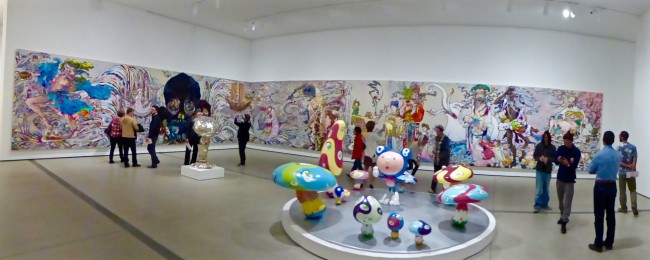 The mural “reflects on the 2011 Tōhoku earthquake and subsequent tsunami in Japan.”
The mural “reflects on the 2011 Tōhoku earthquake and subsequent tsunami in Japan.”
From all angles, this mural was one of the major highlights of The Broad.
I only had a couple of rooms left to go (Tracy, who had been on her lunch hour, had returned to work). Suddenly I was standing next to a ship that turned out to be Chris Burden’s “Bateau de Guerre.” The suspended ship weighs about 400 pounds and is made from small Erector-set girders and foam-filled gas cans. On top of those girders and cans are “toy castles, boats, and airplanes along with egg crates and halogen lamps.”
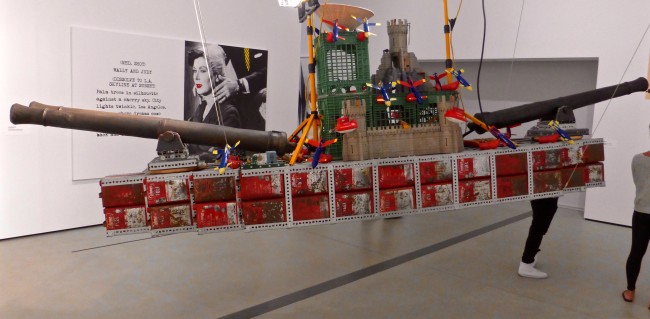 There were only a few pieces of art yet for me to see before leaving. A picture of some partially clothed women at Karl Marx’s gravesite caught my eye. “Death of Marxism, Women of All Lands Unite” is Polish artist Goshka Macuga’s wool tapestry attempt “to end class struggle to a feminist one calling for the end of sexist oppression.”
There were only a few pieces of art yet for me to see before leaving. A picture of some partially clothed women at Karl Marx’s gravesite caught my eye. “Death of Marxism, Women of All Lands Unite” is Polish artist Goshka Macuga’s wool tapestry attempt “to end class struggle to a feminist one calling for the end of sexist oppression.”
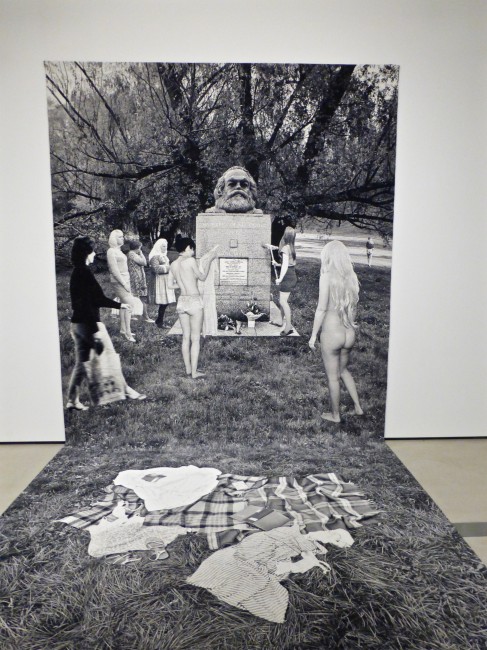 Death rears its head again in Neo Rauch’s “Heillichtung.” I have no idea what the heck it is depicting, but the Grim Reaper does make a cameo appearance.
Death rears its head again in Neo Rauch’s “Heillichtung.” I have no idea what the heck it is depicting, but the Grim Reaper does make a cameo appearance.
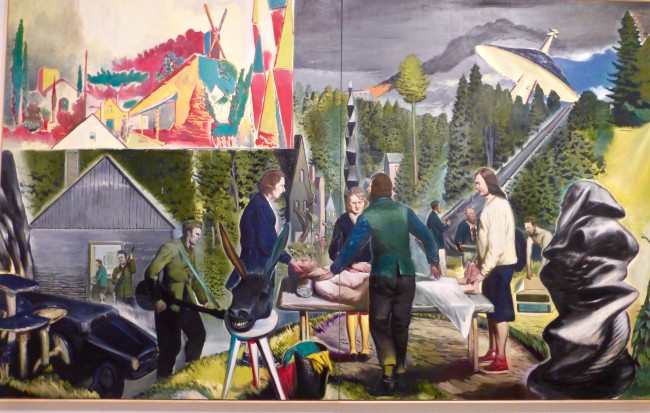 The final painting I saw was Mark Bradford’s “Scorched Earth.” Bradford is an African American artist and his work depicts a blacked out aerial map of a neighborhood once called “Negro Wall Street” in Tulsa, Oklahoma. It was a spot where black businesses thrived until a 1921 race riot “and the violence obliterated this unique area and its history.”
The final painting I saw was Mark Bradford’s “Scorched Earth.” Bradford is an African American artist and his work depicts a blacked out aerial map of a neighborhood once called “Negro Wall Street” in Tulsa, Oklahoma. It was a spot where black businesses thrived until a 1921 race riot “and the violence obliterated this unique area and its history.”
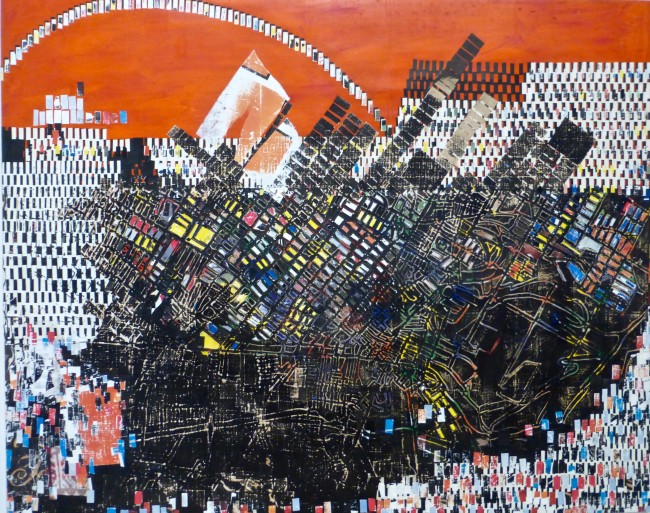 As you can tell, The Broad really sucked us in with interesting art and fascinating tales, and I must return for the “Infinity Mirrored Room.” I believe the best strategy would be to secure tickets very early to The Broad (preferably when it opens), and then immediately go sign in for that experience and receive your timed ticket.
As you can tell, The Broad really sucked us in with interesting art and fascinating tales, and I must return for the “Infinity Mirrored Room.” I believe the best strategy would be to secure tickets very early to The Broad (preferably when it opens), and then immediately go sign in for that experience and receive your timed ticket.
After all the years dissing contemporary art, we finally found a museum that captured our imagination. The Broad is definitely a place I hope to return to soon, as the paintings rotate in and out, and I was not able to see everything today (plus I have to get in that light room).
It only took 63 1/2 years for me to like a contemporary art museum, but The Broad has finally made me a thoroughly modern man. The next thing you know, I’ll start liking pickles.
FACTS:
The Broad
221 S Grand Avenue
Los Angeles, CA 900127
Phone: 213.232.6200
Hours: Tuesday/Wednesday 11 a.m. – 5 p.m. • Thursday/Friday 11 a.m. – 8 p.m. • Saturday 10 a.m. – 8 p.m. • Sunday 10 a.m. 6 p.m.
Cost: Free (Go to the website below and click on “Reserve Free Tickets.” Then choose time, date and number of tickets you want.
For Infinity Mirrored Room: Immediately after entering, go to the kiosk in lobby (look for the line) and get your timed ticket.
Parking: (located on 2nd Street downstairs….$22…hey, at least the tickets are free)
Website: thebroad.org

